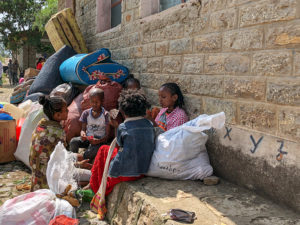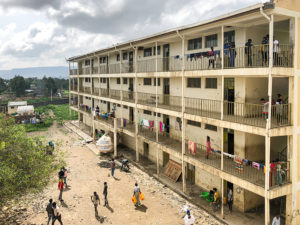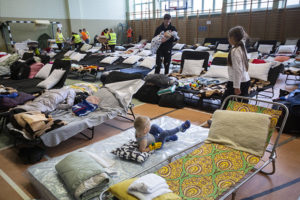Did you know that, according to UNESCO, more than 40% of the world’s out-of-school children live in conflict-affected countries? There are 21 developing countries in the world that spend more on armaments than on primary school. If they cut their military spending by 10 per cent, these countries could provide education for 9.5 million children deprived of their universal right to education (UNESCO, 2011).

ACNUR/Joe Chihane
When a country is in the midst of a conflict situation, it may seem that the education of its children is perhaps not the most immediate need. However, guaranteeing the right to education for the youngest should not be postponed. Safely, of course. Under very special conditions, too. What are these conditions? What should international organisations, host governments of displaced people, and education policy makers in general, consider in these complex situations? Can digital education help facilitate the learning process for children in humanitarian crisis and armed conflict environments? If so, under what conditions and circumstances?
Conflict sensitive education
Within the complex contexts in which humanitarian emergencies and armed conflict take place, and recognising the enormous power and impact of education, the International Network for Education in Emergencies (INEE) has developed guidance standards to enable education practitioners and policy makers to promote conflict-sensitive education strategies that do not contribute to the inequalities and disparities that led to conflict. Education programmes and policies in conflict-affected fragile contexts should serve to reduce negative impacts and increase positive ones (INEE, 2014). The following is a summary of some of the broad outlines and principles of these guidance notes.
Firstly, it is essential to develop an analysis of the conflict, its origin, its history, its causes… everything that can contribute to its origin, to help build peace and, above all, how this interacts with education policies. From here, it will be necessary to build appropriate response strategies that take into account the needs of the affected populations, their group interactions, how the conflict is perceived by each of the groups involved, geographical constraints or how the education response is harmonised with the national education system, among many other factors. There should also be constant monitoring of education activities and their impact on the fragile dynamics that govern these conflict contexts. This monitoring should include variables such as risk factors for schools and students, human rights violations, perceptions of insecurity of educational actors or financial allocation.

ACNUR/Olga Sarrado Mur
In terms of access and learning environments, equal access must be ensured, and safe facilities must be provided that promote the protection and well-being of students, teachers and education personnel. There is also a need to ensure the quality of the teaching and learning process with conflict-sensitive strategies. This is done through culturally, socially and linguistically relevant curricula that include peace-related topics and are not biased towards any one group. Teachers and education personnel should receive regular, relevant and structured professional support and training according to needs and circumstances. Instructional and learning processes should be learner-centred, participatory and inclusive. Finally, context-appropriate, fair and inclusive results analysis and evaluations will need to be carried out to validate the results.
Digital education: a new hope
In these particularly challenging and vulnerable contexts, technology and digital education can help overcome some of the barriers that children face every day. But how can we make the most of these technologies? How can they contribute to resolving these problems and obstacles?
In its report A Lifeline to Learning: Leveraging Technology to Support Education for Refugees UNESCO analyses some key issues in digital education for people in refugee situations, through the analysis of more than 90 projects, apps and digital education platforms, and concludes that technology applied to education can be useful to solve challenges related to language and literacy issues; trauma and issues related to exclusion and isolation; lack of teacher preparation; lack of appropriate and relevant educational resources; and lack of adequate documentation and certification mechanisms, among others.
According to this UNESCO analysis and the experience of organisations such as Save the Children, which has been working on the ground for years, and ProFuturo, which has had a digital education programme adapted to crisis contexts in place since 2017what factors should we take into account when designing a digital education programme that responds to the needs of these children?
Assess the emergency situation
As INEE stated in its guidance standards, when we talk about digital education, the characteristics of the emergency before us will help us to assess and determine whether it is feasible to use technology and, if so, how and which technology may be the most useful (Save the Children, 2018). For example, how long is the disruption to learning expected to last? Can they attend school? Do they have access to formal education? Is there electricity? What about teachers who can help children? Is there internet and data? Answering these questions will help us know how to use technology to facilitate children’s learning and what content needs to be reinforced (Save the Children, 2018). The ProFuturo Foundation’s holistic approach also involves careful assessment of the emergency context in order to ensure safe learning spaces and provide students with appropriate learning materials.

ACNUR
Children’s learning needs
We need to understand what the child has been through, where they are in their learning journey, how long their learning has been interrupted and what they need to learn to stay on track (Save the Children, 2018). In this sense, ProFuturo’s refugee model includes specific psychosocial support.
Needs and values of families
In each emergency context we must assess and understand what families want and need. We need to understand families’ expectations about learning and how they view and are willing to use technology in the home (Save the Children, 2018).
Technology in itself is not enough
We know that designs focused solely on technology do not work. When it comes to providing equitable and inclusive education, especially in these particularly vulnerable settings, far-reaching and multi-dimensional approaches are required, taking into account the different technological, socio-cultural, political, economic and financial aspects of education in contexts of conflict.
Teachers need specific training and support
And this training must go beyond the acquisition of technical skills and knowledge. A total transformation is needed in their conception of what it means to teach and learn, under extremely difficult conditions. Teachers’ views on the use of EdTech and its relevance to learning development may be more important barriers than training, according to Save the Children. Without teacher training there will be no learning. Without appropriate and sustained teacher training, technology will be of no use. In this sense, for example, ProFuturo offers training, accompaniment and continuous support to teachers to promote the integration of technology in the classroom.
Digital and global skills
It’s necessary to promote approaches that help these children to acquire digital competences and 21st-century skills, including programming. We know that these skills are beneficial, not only because they open the door to future job opportunities, but also because they enable them to develop digital solutions for themselves and their peers.
On the other hand, while education does not cause or end wars, education systems often contribute to creating conditions conducive to the outbreak of armed conflict and can also contribute to the creation of more peaceful, cohesive and resilient societies, thus preventing the return of violence (UNESCO, 2011). That is why, education for peace and global citizenship is as important today as mathematics and reading and writing. Critical thinking, collaboration, teamwork… Because we need citizens committed to peace. Today more than ever.
REFERENCES
Inter-Agency Network for Education in Emergencies. 2014. INEE Guidance Notes on Conflict-Sensitive Education. INEE. New York.
Tausaon, M. & Stannard, L. 2018. EdTech for Learning in Emergencies and Displaced Settings. A Rigorous Review and Narrative Synthesis. Save the Children UK. 2018.
UNESCO. 2011. A Crisis in Disguise: Armed Conflict and Education. UNESCO. Paris.
UNESCO. 2018. A Lifeline to Learning: Leveraging Technology to Support Education for Refugees. Paris.






